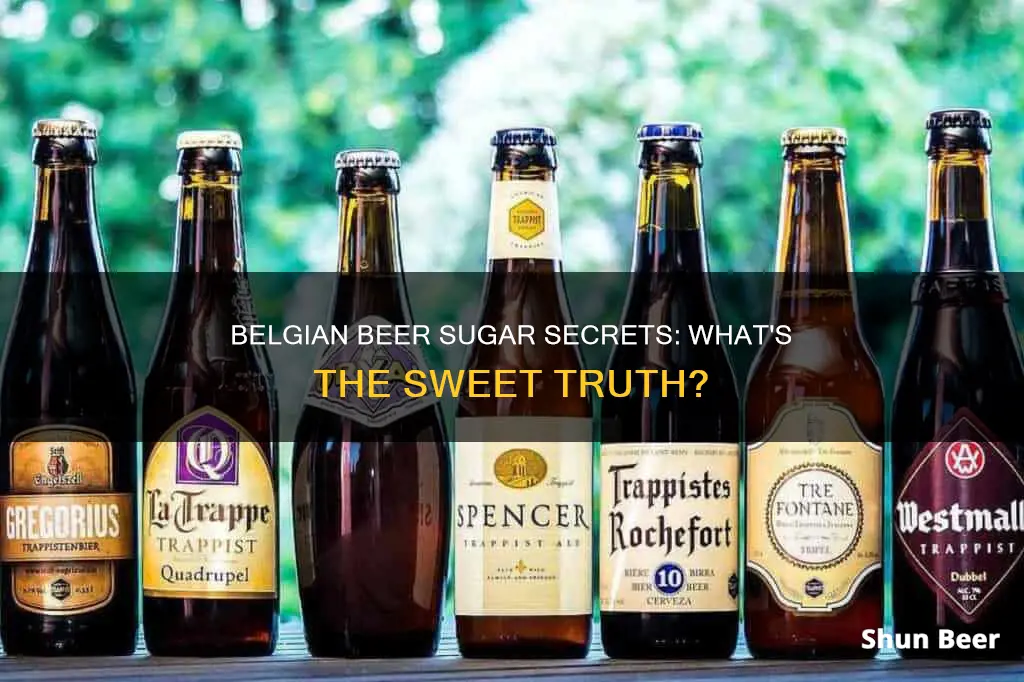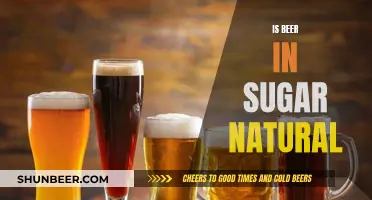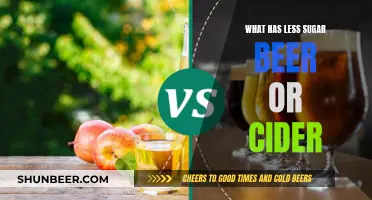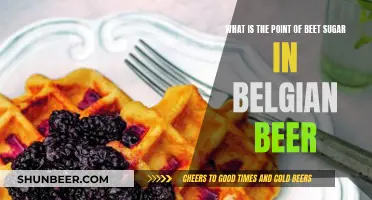
Sugar is commonly used in beer, even if it doesn't come from malt or malt extract. Belgian beers are known to use Belgian Candi Sugar, which is an invert sugar that has been converted from sucrose to a mixture of fructose and glucose. This sugar is derived from beets, as opposed to the sugar bought in stores, which is derived from sugar canes. Belgian Candi Sugar is used to boost the alcohol content of beers without adding extra body to it. It is also used as a priming sugar. Belgian beers also use Belgian Candi Syrup, which is similar to the sugar but in a viscous liquid form. Candi syrup comes in various flavors, such as maple and smoked bacon, chipotle pepper, blood orange, cacao nibs, and tart cherry.
What You'll Learn

Belgian candi sugar is made from beets
Belgian candi sugar is a sugar product commonly used in brewing stronger Belgian beers such as dubbels and tripels. It is derived from sugar beets and is chemically an unrefined sugar. The use of Belgian candi sugar boosts the alcohol content without adding extra body to the beer.
The manufacturing process of Belgian candi sugar and table sugar is fairly similar. However, the main difference lies in the chemical composition of the final product. Belgian candi sugar is composed of fructose and glucose, while table sugar is sucrose. This difference in composition affects how easily yeast can digest the sugars. Yeast can more easily digest fructose and glucose, while sucrose requires an additional step in which the yeast creates an enzyme to help break down the sucrose into fructose and glucose.
Belgian candi sugar is also used as a priming sugar, aiding in bottle conditioning and carbonation. It can be used to contribute distinct flavours to the beer, such as toasted toffee, caramel, dark fruit, and chocolate.
Sugar in Beer: How Much is Too Much?
You may want to see also

Candi sugar is easier for yeast to digest
Sucrose is a disaccharide, a complex sugar composed of two glucose molecules. Yeast finds it tricky to break down these molecules and has to create an enzyme to help. This extra step is not needed with candi sugar.
Candi sugar is an invert sugar, which means it has been converted from sucrose. This can be done by heating it with water and an acid. Candi sugar is used in stronger Belgian beers such as Dubbel and Tripel to boost the alcohol content without adding extra body to the beer.
Yeast needs sugar to ferment, but the type and amount of sugar matter. Too much sugar can cause yeast to rush through the fermentation process, potentially becoming overwhelmed and producing off-flavours.
There are fermentable and non-fermentable sugars. Yeast utilises different types of sugar differently. Yeast has no problem breaking down the fermentable sugars in grapes, for example, which are rich in fructose and glucose. However, grains used to make beer are rich in maltose, which is more difficult for yeast to break down.
Non-Alcoholic Beer: Sugar-Free or Not?
You may want to see also

Candi sugar boosts alcohol content without adding body
Candi sugar is a flexible ingredient that can be used in the production of some of the best, rarest, and most exotic beers in the world. It is an invert sugar, which means it has been converted from sucrose to a mixture of fructose and glucose by heating with water and some acid. This process makes it easier for yeast to digest compared to table sugar.
Candi sugar is often used in stronger Belgian beers such as dubbels and tripels to boost their alcohol content without adding extra body or forcing the yeast to produce invertase. The sugar adds gravity points with minimal impact on flavor and color. However, darker caramelized candi sugars can add distinct flavors and colors to beers.
The use of candi sugar in brewing has both advantages and drawbacks. It can be an expensive and extravagant ingredient, with some arguing that it has minimal impact on flavor. On the other hand, it can add subtle flavors, such as cocoa, fig, smooth caramel, and light citrus, and create jewel-toned amber and copper colors. It also helps produce lighter, more digestible, higher-ABV beers, which is in line with traditional Belgian brewing philosophy.
Ultimately, the role of candi sugar in brewing depends on the specific type of candi sugar used, how it is used, and the quantity added. Brewers can experiment with different colors and forms (rock or syrup) of candi sugar to find the right balance of flavor, body, and alcohol content in their beers.
Beer and Sugar: Friends or Foes?
You may want to see also

Candi sugar is used in stronger Belgian beers
Candi sugar is a type of sugar commonly used in brewing stronger Belgian beers such as Dubbel and Tripel. It is made from beets, whereas the sugar typically bought in stores comes from sugar canes. Candi sugar is also known as "invert sugar" because it has been converted from sucrose to a mixture of fructose and glucose by heating with water and some acid. This process makes it easier for yeast to digest.
Candi sugar comes in different colours, including clear, light, dark, and extra dark, and can be used to manipulate the colour of the beer. It also imparts desirable flavours to the beer that cannot be achieved with table sugar. For example, dark candi sugar can contribute distinguishable toasted toffee and caramel flavours, while extra dark candi sugar can impart hints of dark raisin and extra dark stone fruit.
Some brewers prefer to use candi sugar because it is invert sugar, which is supposedly easier for yeast to digest. However, it is well known that yeast can produce invertase, the enzyme responsible for breaking down sucrose into fructose and glucose. Therefore, the use of processed sugars like candi sugar may not be necessary. Nonetheless, candi sugar is a popular choice for brewing stronger Belgian beers due to the unique flavours and colours it can impart.
Sugar's Effect on Beer Carbonation: Does it Fizz or Flop?
You may want to see also

Candi sugar is also used in British beers
Candi sugar is a Belgian sugar product commonly used in brewing beer. It is often used in stronger Belgian-style ales such as dubbels and tripels. The sugar is derived from beets and is chemically an unrefined sugar that has been subjected to the Maillard reaction and caramelization.
The use of candi sugar in brewing is a paradox. It is both an underused and overused ingredient. Brewers of Belgian strong ales know that candi sugar plays a valuable role in brewing, but it can also be an extravagant waste of resources for brewers who could achieve the same effect with corn sugar (dextrose).
The flavour of candi sugar is rich, and brewers use it as a source of fermentables and flavours. Candi sugar can be used to add colour to beers, as well as distinct flavours. It is available in several forms and colours, including rock form (a crystalized sugar) and syrup. The syrup is generally easier to work with, but brewers must be cautious to fully dissolve added sugars in the kettle to avoid caramelization.
Candi sugar is also used as a priming sugar, to aid in bottle conditioning and carbonation. It can be used to thin the body of a beer and increase the ABV.
Sugar Secrets: Lite Beer's Sweet Surprise
You may want to see also
Frequently asked questions
Belgian candi sugar is a type of sugar used in brewing, particularly in stronger Belgian beers such as Dubbel and Tripel. It is made from beets and is easier for yeast to digest than table sugar.
Table sugar is made from sugar canes, whereas Belgian candi sugar is made from beets. Belgian candi sugar is also easier for yeast to digest as it is made up of fructose and glucose, whereas table sugar is made up of sucrose.
Belgian candi sugar boosts the alcohol content of beer without adding extra body or forcing the yeast to produce invertase. It can also be used to manipulate the colour of the beer.







